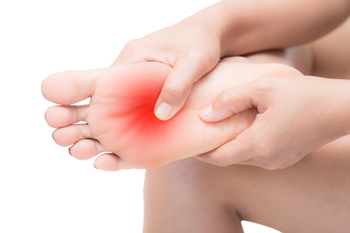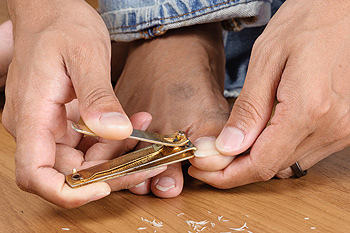Items filtered by date: March 2020
Who Is Most Susceptible To Getting Gout?
 Severe pain and discomfort in the big toe and surrounding areas may be indicative of a condition that is known as gout. This is an ailment that may appear suddenly, also known as a gout attack. The pain may be so debilitating that it can be difficult to walk. It occurs as a result of excess uric acid in the bloodstream, which may come from specific causes. These may include genetic factors, and eating foods that have elevated purine levels which can consist of shellfish, red meat, or drinks that have unusually high sugar levels. Research has indicated that this form of arthritis generally affects more men than women, and may be common in patients who are overweight. It may be helpful to obtain a proper diagnosis, which can be achieved by having a blood test performed. This can be beneficial in determining existing uric acid levels. Some patients may use braces or canes to relieve excess pressure that falls on the joints. If you feel you may have gout, it is strongly advised that you schedule a consultation with a podiatrist who can help you to manage this condition.
Severe pain and discomfort in the big toe and surrounding areas may be indicative of a condition that is known as gout. This is an ailment that may appear suddenly, also known as a gout attack. The pain may be so debilitating that it can be difficult to walk. It occurs as a result of excess uric acid in the bloodstream, which may come from specific causes. These may include genetic factors, and eating foods that have elevated purine levels which can consist of shellfish, red meat, or drinks that have unusually high sugar levels. Research has indicated that this form of arthritis generally affects more men than women, and may be common in patients who are overweight. It may be helpful to obtain a proper diagnosis, which can be achieved by having a blood test performed. This can be beneficial in determining existing uric acid levels. Some patients may use braces or canes to relieve excess pressure that falls on the joints. If you feel you may have gout, it is strongly advised that you schedule a consultation with a podiatrist who can help you to manage this condition.
Gout is a foot condition that requires certain treatment and care. If you are seeking treatment, contact Dr. Steven Sheridan from Ankle & Foot Specialty Clinics. Our doctor will treat your foot and ankle needs.
What Is Gout?
Gout is a type of arthritis caused by a buildup of uric acid in the bloodstream. It often develops in the foot, especially the big toe area, although it can manifest in other parts of the body as well. Gout can make walking and standing very painful and is especially common in diabetics and the obese.
People typically get gout because of a poor diet. Genetic predisposition is also a factor. The children of parents who have had gout frequently have a chance of developing it themselves.
Gout can easily be identified by redness and inflammation of the big toe and the surrounding areas of the foot. Other symptoms include extreme fatigue, joint pain, and running high fevers. Sometimes corticosteroid drugs can be prescribed to treat gout, but the best way to combat this disease is to get more exercise and eat a better diet.
If you have any questions please feel free to contact our office located in Sandusky, MI . We offer the newest diagnostic and treatment technologies for all your foot and ankle needs.
How Is Morton’s Neuroma Diagnosed?
 The pain that is typically associated with Morton’s neuroma is felt in the ball of the foot. Many patients often describe it as a sharp, burning pain, and it may feel like there is a small stone in your shoe. This condition may develop from wearing shoes that are too tight, or from participating in high impact activities. Additionally, people who have foot conditions that can include bunions and hammertoes, or who are significantly overweight, may also experience Morton’s neuroma. This ailment is defined as growths that form around the nerves between the second and third toes, and when pressure is added, may cause pain and discomfort. A proper diagnosis generally consists of having an MRI taken, as this may be effective in identifying unwanted growths. If you are afflicted with Morton's neuroma, it is strongly suggested that you schedule a consultation with a podiatrist who can treat this condition.
The pain that is typically associated with Morton’s neuroma is felt in the ball of the foot. Many patients often describe it as a sharp, burning pain, and it may feel like there is a small stone in your shoe. This condition may develop from wearing shoes that are too tight, or from participating in high impact activities. Additionally, people who have foot conditions that can include bunions and hammertoes, or who are significantly overweight, may also experience Morton’s neuroma. This ailment is defined as growths that form around the nerves between the second and third toes, and when pressure is added, may cause pain and discomfort. A proper diagnosis generally consists of having an MRI taken, as this may be effective in identifying unwanted growths. If you are afflicted with Morton's neuroma, it is strongly suggested that you schedule a consultation with a podiatrist who can treat this condition.
Morton’s neuroma is a very uncomfortable condition to live with. If you think you have Morton’s neuroma, contact Dr. Steven Sheridan of Ankle & Foot Specialty Clinics. Our doctor will attend to all of your foot care needs and answer any of your related questions.
Morton’s Neuroma
Morton's neuroma is a painful foot condition that commonly affects the areas between the second and third or third and fourth toe, although other areas of the foot are also susceptible. Morton’s neuroma is caused by an inflamed nerve in the foot that is being squeezed and aggravated by surrounding bones.
What Increases the Chances of Having Morton’s Neuroma?
- Ill-fitting high heels or shoes that add pressure to the toe or foot
- Jogging, running or any sport that involves constant impact to the foot
- Flat feet, bunions, and any other foot deformities
Morton’s neuroma is a very treatable condition. Orthotics and shoe inserts can often be used to alleviate the pain on the forefront of the feet. In more severe cases, corticosteroids can also be prescribed. In order to figure out the best treatment for your neuroma, it’s recommended to seek the care of a podiatrist who can diagnose your condition and provide different treatment options.
If you have any questions, please feel free to contact our office located in Sandusky, MI . We offer the newest diagnostic and treatment technologies for all your foot care needs.
Why Do I Have an Ingrown Toenail?
 When the toenail grows into the flesh instead of over it, it is referred to as an ingrown toenail. The big toe is usually the most common to become affected. This condition can be particularly painful and may lead to an infection if left untreated. To help prevent an ingrown toenail, it is recommended that you trim the toenails properly, which is straight across, not on a curve or following the shape of your toe. Additionally, toenails should not be trimmed too short. Symptoms associated with ingrown toenails generally include swelling and redness around the affected area. Additionally, for more severe cases, you may notice bleeding or oozing of pus, which can be an indication that an infection has developed. To safely treat an ingrown toenail it is suggested that you consult with a podiatrist.
When the toenail grows into the flesh instead of over it, it is referred to as an ingrown toenail. The big toe is usually the most common to become affected. This condition can be particularly painful and may lead to an infection if left untreated. To help prevent an ingrown toenail, it is recommended that you trim the toenails properly, which is straight across, not on a curve or following the shape of your toe. Additionally, toenails should not be trimmed too short. Symptoms associated with ingrown toenails generally include swelling and redness around the affected area. Additionally, for more severe cases, you may notice bleeding or oozing of pus, which can be an indication that an infection has developed. To safely treat an ingrown toenail it is suggested that you consult with a podiatrist.
Ingrown toenails can become painful if they are not treated properly. For more information about ingrown toenails, contact Dr. Steven Sheridan of Ankle & Foot Specialty Clinics. Our doctor can provide the care you need to keep you pain-free and on your feet.
Ingrown Toenails
Ingrown toenails occur when a toenail grows sideways into the bed of the nail, causing pain, swelling, and possibly infection.
Causes
- Bacterial infections
- Improper nail cutting such as cutting it too short or not straight across
- Trauma to the toe, such as stubbing, which causes the nail to grow back irregularly
- Ill-fitting shoes that bunch the toes too close together
- Genetic predisposition
Prevention
Because ingrown toenails are not something found outside of shoe-wearing cultures, going barefoot as often as possible will decrease the likeliness of developing ingrown toenails. Wearing proper fitting shoes and using proper cutting techniques will also help decrease your risk of developing ingrown toenails.
Treatment
Ingrown toenails are a very treatable foot condition. In minor cases, soaking the affected area in salt or antibacterial soaps will not only help with the ingrown nail itself, but also help prevent any infections from occurring. In more severe cases, surgery is an option. In either case, speaking to your podiatrist about this condition will help you get a better understanding of specific treatment options that are right for you.
If you have any questions please feel free to contact our office located in Sandusky, MI . We offer the newest diagnostic and treatment technologies for all your foot and ankle needs.
Wounds That Don't Heal Need to Be Checked
Wearing High Heels While Working
 Many patients experience foot pain at the end of their working day. This may be a result of wearing shoes that do not fit correctly, or it may come from standing for extended periods of time throughout the day. Some work environments require high heels to be worn. If this is true for you, it may be beneficial to wear the lowest heel that is acceptable in the work environment, in addition to frequently stretching the calf muscles during the day. Additionally, it may be favorable to wear shoes that are made of breathable materials, and to alternate them with another pair, as this may help to avoid discomfort. If you would like additional information about how to protect your feet while working, please schedule an appointment with a podiatrist.
Many patients experience foot pain at the end of their working day. This may be a result of wearing shoes that do not fit correctly, or it may come from standing for extended periods of time throughout the day. Some work environments require high heels to be worn. If this is true for you, it may be beneficial to wear the lowest heel that is acceptable in the work environment, in addition to frequently stretching the calf muscles during the day. Additionally, it may be favorable to wear shoes that are made of breathable materials, and to alternate them with another pair, as this may help to avoid discomfort. If you would like additional information about how to protect your feet while working, please schedule an appointment with a podiatrist.
While working on the feet, it is important to take the proper care of them. For more information about working on your feet, contact Dr. Steven Sheridan from Ankle & Foot Specialty Clinics. Our doctor will treat your foot and ankle needs.
Working on Your Feet
Standing on your feet for long periods of time can cause stress and pain in your feet. Your whole body may experience change in terms of posture, back pain, bunions, callouses and or plantar warts. There are ways to avoid these conditions with proper foot care, smart choices and correct posture.
Positive Changes
Negative heeled shoe – Choosing this shoe type places the heel slightly lower than the ball of the foot. These are great for overall foot health. Find shoes that fit you correctly.
Go barefoot – Our feet were not designed to be enclosed for all hours of the day. Try to periodically expose your feet to air.
Eliminate Pain
Foot Exercises – Performing simple exercises, incorporating yoga and doing stretches are beneficial. This will allow increased blood flow to the area and muscles of the foot.
Achilles tendon – Stretching the foot out flat on the floor will relax the calf muscles and tendon. These exercises can be performed almost anywhere. Make sure you add these exercises to your daily regimen.
With a little bit of this information and knowing more about foot health, you will notice changes. Foot stretches and proper footwear will help with pain and prevent further issues.
If you have any questions please feel free to contact our office located in Sandusky, MI . We offer the newest diagnostic and treatment technologies for all your foot and ankle needs.
Treating Your Child’s Ingrown Toenail
 When it comes to caring for your child’s feet, it’s important you look for symptoms of any existing or developing foot conditions. One common condition that can develop among babies and young children is an ingrown toenail. Ingrown toenails are characterized by a toenail that grows into the skin on the side of the toe, often appearing red and swollen. Typically, it is more common that the big toe is affected by this condition. In more severe cases, a white or yellowish liquid may drain from the affected toe, which normally is a sign that an infection in present. To help prevent this condition from afflicting your child’s toes, it’s recommended that you make sure you’re cutting their toenails straight across and that they wear footwear that is not too constricting or tightly fitted. Ingrown toenails are often quite painful and should be treated with professional care. For a safe recovery, and to avoid the development of an infection, we suggest you consult with a podiatrist as soon as possible to treat your child’s ingrown toenail.
When it comes to caring for your child’s feet, it’s important you look for symptoms of any existing or developing foot conditions. One common condition that can develop among babies and young children is an ingrown toenail. Ingrown toenails are characterized by a toenail that grows into the skin on the side of the toe, often appearing red and swollen. Typically, it is more common that the big toe is affected by this condition. In more severe cases, a white or yellowish liquid may drain from the affected toe, which normally is a sign that an infection in present. To help prevent this condition from afflicting your child’s toes, it’s recommended that you make sure you’re cutting their toenails straight across and that they wear footwear that is not too constricting or tightly fitted. Ingrown toenails are often quite painful and should be treated with professional care. For a safe recovery, and to avoid the development of an infection, we suggest you consult with a podiatrist as soon as possible to treat your child’s ingrown toenail.
The health of a child’s feet is vital to their overall well-being. If you have any questions regarding foot health, contact Dr. Steven Sheridan of Ankle & Foot Specialty Clinics. Our doctor can provide the care you need to keep you pain-free and on your feet.
Tips for Keeping Children's Feet Healthy
- Make sure their shoes fit properly
- Look for any signs of in-toeing or out-toeing
- Check to see if they have Clubfoot (condition that affects your child’s foot and ankle, twisting the heel and toes inward) which is one of the most common nonmajor birth defects.
- Lightly cover your baby’s feet (Tight covers may keep your baby from moving their feet freely, and could prevent normal development)
- Allow your toddler to go shoeless (Shoes can be restricting for a young child’s foot)
- Cut toenails straight across to avoid ingrown toenails
- Keep your child’s foot clean and dry
- Cover cuts and scrapes. Wash any scratches with soap and water and cover them with a bandage until they’ve healed.
If you have any questions, please feel free to contact our office located in Sandusky, MI . We offer the newest diagnostic and treatment technologies for all your foot care needs.

